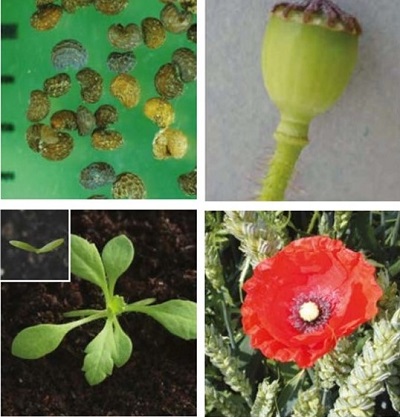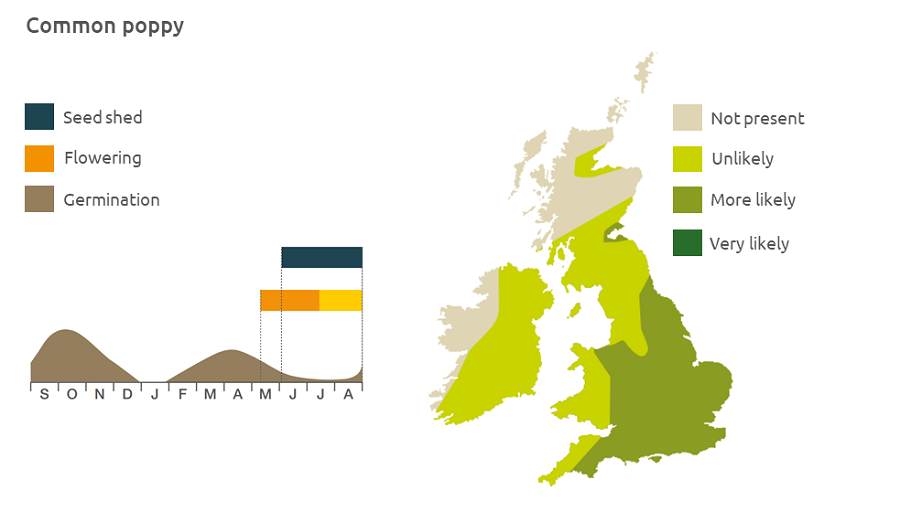- Home
- Knowledge library
- Distribution and biology of common poppy in the UK
Distribution and biology of common poppy in the UK
Common poppy is a broad-leaved weed that can be a particular problem in winter oilseed rape. Find out how to identify and control it.
Overview
Common poppy (Papaver rhoeas) occurs particularly in winter cereals and oilseed rape where it is competitive, but is also found in spring crops, fallows and more rarely vegetables and clover crops. Autumn-germinating seedlings can overwinter. Plants flower in midsummer, but there may be a second flush of flowers once the wheat crop has been harvested. The plant reproduces entirely by seed. The very long seed persistence means that poppy appears in newly cultivated land.
- It is particularly competitive in winter oilseed rape
- Some populations are associated with herbicide resistance
- It has value to biodiversity
Weed Resistance Action Group (WRAG)
Description
It is an upright, hairy annual 20–80 cm tall. The stems are bristly and sometimes spreading. The dull green leaves at the base form a rosette with divided segments. The broken stem bleeds a white sap. The large flowers have four petals sometimes with a large black spot at the centre. The ovary is short and smooth.
Key features
Fruit: The seed head is short and smooth.
Lookalikes
Common poppy may be confused with young plants of shepherd’s-purse but the cotyledons of common poppy are narrower. The hairs of the common poppy stand singly and may be forked, while those of shepherd’s-purse form little star-like clusters.

Location and life cycle

Geographic distribution
Poppy is widely distributed in all areas of the British Isles, but is less abundant in northern Scotland. It tends to prefer lowland areas.
Soil type
Poppy is widely distributed in all areas of the British Isles, but is less abundant in northern Scotland. It tends to prefer lowland areas.
Seed statistics
- Seed longevity: Up to 100 years
- Germination depth: 0.5 cm
- Seed weight: 0.09 mg
- Seeds/flower: 1,360
- Seeds/plant: 20,000
Management
The best control method is to stimulate germination through cultivation before spraying with glyphosate.
For advice on herbicides, please speak with your agronomist or adviser.
Herbicide resistance
- ALS-resistant populations of poppy have been found in 13 counties in England
- Resistance is conferred by ALS target site resistance mutations (e.g. Pro-197-Leu or Pro-197-His)
- These mutations confer high levels of resistance to the sulfonylurea herbicides, metsulfuron and tribenuron
Resistant poppy seeds are likely to persist in the soil seedbank for many years (>10 years).
The results of regular herbicide resistance tests (on seeds or plants) provide a strong indication of the unique resistance profiles present across each field.
- Collect poppy seeds when the seedpods become a greyish-brown colour (July/August)
- The brown seed heads will begin to open just under the ‘lid’ and a row of holes will be visible
- Cut the seedpods from the stem and place in a paper bag or envelope
- Leave the seeds in a well-ventilated area, keeping the bag open to the air to promote drying
How to detect herbicide resistance in arable weeds
When was this information last updated?
This page is based on content from the encyclopaedia of arable weeds publication. Since it was first released in 2008, the publication has been redesigned several times but not revised. However, it remains a good foundation for general information on the distribution and biology of weeds.

